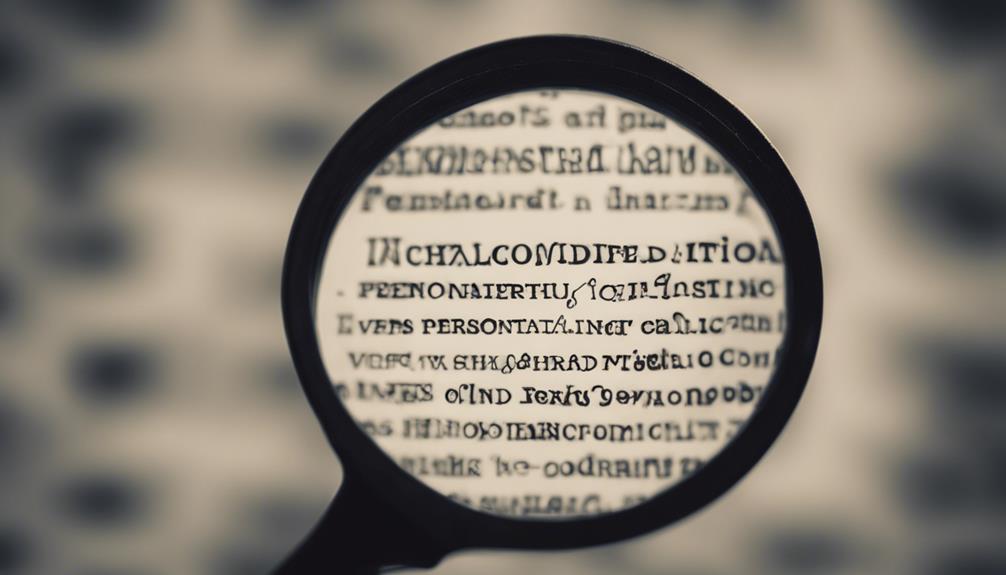Grasping figurative language and rhetorical tools is vital for digging into the heart of literature. Similes make comparisons using **’like’** or **’as’**, while metaphors **paint vivid pictures** by saying something **is** something else. Personification **breathes life into objects**, making them feel human, and hyperboles **stretch the truth** for dramatic effect. Onomatopoeia **brings sounds to the mind’s ear**, enhancing the sensory feel of the story. Spotting these cool tricks in writings uncovers **hidden layers of meaning** and intricate wordplay. Exploring figurative language **boosts your love for stories**, the emotions they stir, and the tough topics they tackle. Each of these devices **turns plain talk into colorful scenes**, **deepening tales** beautifully and leaving a powerful mark on readers.
Key Takeaways
- Figurative language includes similes, metaphors, personification, hyperboles, and onomatopoeia for rich descriptions.
- Recognize rhetorical devices like comparisons, substitutions, and human traits in texts for deeper meanings.
- Figurative elements in literature and poetry evoke emotions, convey complex themes, and add layers of meaning.
- Authors use metaphors, similes, and personification in prose to enhance storytelling and engage readers effectively.
- Rhetorical devices enhance persuasive communication by appealing to logic, emotions, and ethics for impactful messages.
Types of Figurative Language
In exploring the domain of figurative language, we encounter various types that vividly enhance our communication skills. Understanding similes is essential as they compare two things using 'like' or 'as', creating vivid descriptions that paint clear images in our minds. Metaphors, on the other hand, directly compare two things without using 'like' or 'as', allowing for deeper meanings and associations to be conveyed in a concise manner.
Personification is another powerful tool that attributes human qualities to non-human entities, making them more relatable and vivid. This technique adds layers of depth to our descriptions, evoking emotions and creating connections with the reader. Hyperboles, known for their exaggeration for emphasis, add a dramatic effect and intensity to the language, making a point stand out with heightened impact.
Onomatopoeia, by using words that mimic the sounds they represent, enhances sensory experiences in writing, bringing scenes to life with auditory vividness. Mastering these various types of figurative language elevates our ability to express ideas with creativity and precision.
Identifying Rhetorical Devices

When it comes to identifying rhetorical devices, we should pay attention to device examples and recognize patterns in language.
By pinpointing similes, metaphors, personification, and other devices, we uncover layers of meaning and creativity in communication.
Understanding these devices helps us analyze texts more deeply and appreciate the richness of language.
Device Examples
Spotting rhetorical devices in writing becomes easier when we can identify specific examples like similes, metaphors, personification, hyperboles, and onomatopoeia. Here are some ways to recognize these literary devices:
- Simile: Look for comparisons using words like 'like' or 'as,' e.g., 'as brave as a lion.'
- Metaphor: Find direct comparisons without 'like' or 'as,' such as 'time is a thief.'
- Personification: Note human traits given to non-human things, like 'the wind whispered through the trees.'
Recognizing Patterns
Moving from recognizing specific examples of rhetorical devices to identifying patterns in language structures and word choices can deepen our understanding of how writers use figurative language for effect. By recognizing patterns such as comparisons, substitutions, and human traits assigned to non-human things, we can enhance our understanding of figurative language.
This deeper understanding allows us to grasp the purpose and impact of each rhetorical device, making it easier to spot them in written or spoken communication. Analyzing the context and overall message of a text provides valuable clues for identifying rhetorical devices used by the author.
With practice and exposure to various examples of rhetorical devices, our ability to recognize them in different forms of communication can greatly improve.
Figurative Language in Literature

Figurative language in literature, comprising metaphors, similes, personification, hyperboles, and onomatopoeia, enriches storytelling by infusing depth, imagery, and emotional resonance into literary works.
- Enhances storytelling: Figurative language in literature helps authors evoke strong emotions, create vivid imagery, and engage readers on a deeper level.
- Conveys abstract concepts: It assists in conveying abstract concepts, intricate relationships, and complex themes effectively.
- Adds layers of meaning: The use of figurative language in literature adds layers of meaning, symbolism, and creativity to the narrative, making it more engaging and memorable.
Authors strategically employ these figurative elements to transform ordinary language into a tapestry of vivid descriptions and emotional connections. Metaphors and similes draw parallels between unrelated concepts, while personification breathes life into inanimate objects. Hyperboles exaggerate for effect, and onomatopoeia mimics sounds, immersing readers in the world created by the writer.
This rich tapestry of language enhances the beauty and impact of literary works, inviting readers to explore complex themes and emotions in a more profound manner.
Rhetorical Devices in Poetry

Exploring the intricate use of rhetorical devices in poetry reveals the artistry and depth embedded in poetic expressions. Poets skillfully employ metaphors, similes, personification, hyperboles, and onomatopoeia to enhance their works. These devices serve to add layers of meaning, evoke vivid imagery, and elicit emotional responses from readers. By incorporating these rhetorical devices, poets can convey complex ideas in a condensed and impactful manner, engaging the audience on multiple levels.
| Rhetorical Device | Description |
|---|---|
| Metaphor | Implied comparison |
| Simile | Explicit comparison |
| Personification | Giving human traits to objects |
| Hyperbole | Exaggeration for emphasis |
| Onomatopoeia | Imitating sounds with words |
| Imagery | Creating vivid mental pictures |
Understanding and analyzing these rhetorical devices enriches the reader's experience, allowing for a deeper appreciation of the beauty and craftsmanship inherent in poetry. The careful use of these devices not only enhances the aesthetic value of poems but also helps in conveying the poet's intended message effectively.
Figurative Language in Prose

Analyzing prose for figurative language reveals how authors skillfully employ rhetorical devices to enhance the depth and emotional impact of their writing.
Figurative language in prose, such as metaphors, similes, and personification, serves various purposes:
- Metaphors: Authors use metaphors in prose to create vivid comparisons between two seemingly unrelated things, allowing readers to see familiar concepts in a new light.
- Similes: Similes, like metaphors, draw comparisons, but they use 'like' or 'as' to link two elements. They help readers visualize abstract ideas by likening them to more concrete objects.
- Personification: Giving human attributes to non-human entities through personification adds a layer of depth to prose, making the writing more engaging and relatable.
Everyday Rhetorical Devices

In everyday conversations, we frequently employ rhetorical devices like idioms, metaphors, and hyperboles to add vibrancy and expressiveness to our language. These devices go beyond their literal meanings, allowing us to convey complex ideas and human characteristics in a more engaging manner.
Idioms, such as 'raining cats and dogs,' add color to our speech by using figurative language to express situations vividly. Metaphors, like 'time is a thief,' help us draw parallels between two unrelated things, enhancing our descriptions and comparisons. Hyperboles, such as 'I've told you a million times,' inject humor and exaggeration into our statements, making them more memorable.
Importance of Rhetorical Devices

Rhetorical devices hold significant importance as they have a direct impact on how effectively we communicate with others, enhancing our ability to persuade and engage our audience.
By incorporating these devices into our writing and speeches, we can make our messages more compelling and memorable, leaving a lasting impression on those we interact with.
Understanding and utilizing rhetorical devices can be a powerful tool in various contexts, from literature and poetry to everyday conversations, enabling us to express ideas in a more impactful and engaging manner.
Rhetorical Devices Impact
Enhancing communication with depth, emotion, and creativity, rhetorical devices play a pivotal role in engaging audiences and conveying complex ideas effectively.
- Rhetorical devices tap into human characteristics, infusing figurative language with vivid imagery.
- By skillfully using words, they go beyond the literal meaning of words to add depth to communication.
- They're essential for maneuvering complex ideas, making them accessible and engaging for the audience.
Enhancing Persuasive Communication
Pivoting from the impact of rhetorical devices on communication, it becomes evident that incorporating these tools is key to effectively enhancing persuasive communication.
Metaphors and analogies, as forms of figurative language, play an important role in conveying complex ideas in a relatable manner. By weaving vivid imagery into our discourse, we can establish emotional connections with our audience, thereby amplifying the impact of our message.
Utilizing rhetorical devices not only influences opinions but also stirs deep emotions and motivates action in our listeners. These tools appeal to logic, emotions, and ethics, reinforcing arguments and making them compelling and memorable.
Mastering rhetorical devices empowers us to communicate persuasively, whether through spoken words or written text, in a manner that captivates and convinces our audience.
Engaging Audience Effectively
Engaging our audience effectively relies heavily on the skillful integration of rhetorical devices to enhance communication impact. Rhetorical devices like metaphor and simile play an essential role in captivating audience engagement by painting vivid mental images.
To master audience engagement, consider the following:
- Metaphors: Transform abstract concepts into tangible human characteristics.
- Similes: Draw parallels to familiar experiences, aiding audience understanding.
- Vivid Mental Images: Create memorable and relatable content that resonates with the audience.
Frequently Asked Questions
What Rhetorical Device Is Figurative Language?
Figurative language is a type of rhetorical device used to communicate ideas beyond their literal meanings. It includes metaphors, similes, personification, hyperboles, and idioms. These elements enhance communication by adding depth, creativity, and impact to writing and speech.
Understanding figurative language is vital for decoding and appreciating various rhetorical devices in communication.
What Are the 5 Types of Figurative Language?
We've got the scoop on the five types of figurative language!
Simile, metaphor, personification, hyperbole, and onomatopoeia are the stars of the show. Each one brings a unique flavor to writing.
Simile compares using like or as, while metaphor dives deeper without those comparison terms.
Personification gives life to non-human things, hyperbole goes big for effect, and onomatopoeia mimics sounds.
Understanding these types adds depth to literary works and everyday conversations.
What Is the Figurative Language Understanding?
Understanding figurative language entails interpreting expressions beyond their literal meanings. It involves recognizing metaphors, similes, personification, hyperboles, and idioms to add depth and creativity to communication.
Recognizing comparisons, personification, exaggerations, and sound imitations aids in appreciating the role of figurative language in literature, poetry, conversations, and popular culture. It enriches language by infusing it with deeper layers of meaning and emotion.
How Can I Interpret Figurative Language?
To interpret figurative language effectively, we analyze comparisons, like those using 'like' or 'as,' and recognize personification, hyperboles, and onomatopoeia. Inferring from context and sticking to literal meanings of words help decode unknown idioms and similes.
Leveraging human-inspired models with event-centered inferences or concept-centered knowledge enhances understanding. Despite challenges highlighted in evaluating language models, mastering these strategies boosts comprehension of figurative expressions like idioms and similes.
Can Understanding Rhetorical Devices Help in Decoding Figurative Language in ‘Where I’m From’?
Understanding rhetorical devices can greatly assist in decoding figurative language techniques used in “Where I’m From.” The use of metaphors, similes, and personification adds depth and emotion to the poem’s imagery. By recognizing these literary devices, readers can unravel the hidden meanings and fully appreciate the poet’s words.
Conclusion
To sum up, grasping rhetorical devices is essential for interpreting and appreciating various forms of literature and communication.
By identifying and analyzing figurative language in poetry, prose, and everyday speech, we can gain a deeper insight into the intended messages and emotions conveyed by the writer or speaker.
Just as a skilled musician uses different notes and rhythms to create a harmonious melody, mastering rhetorical devices allows us to decode the intricate layers of meaning within language.











